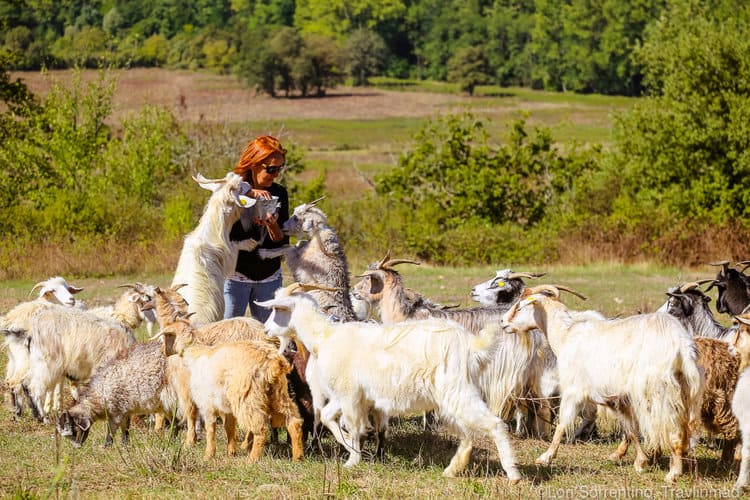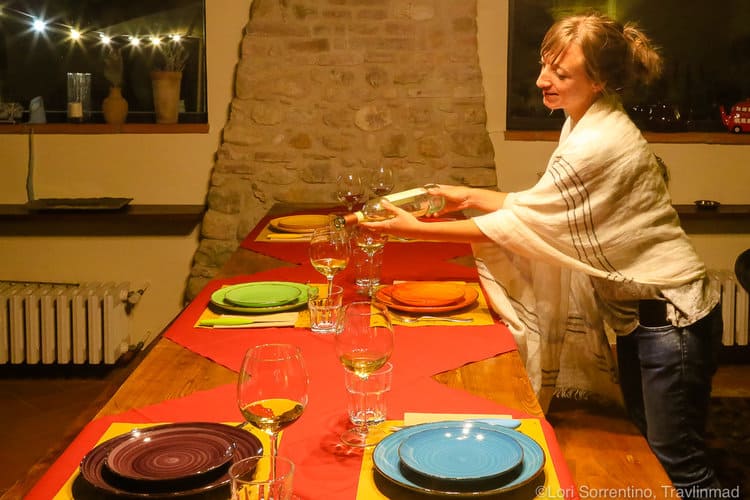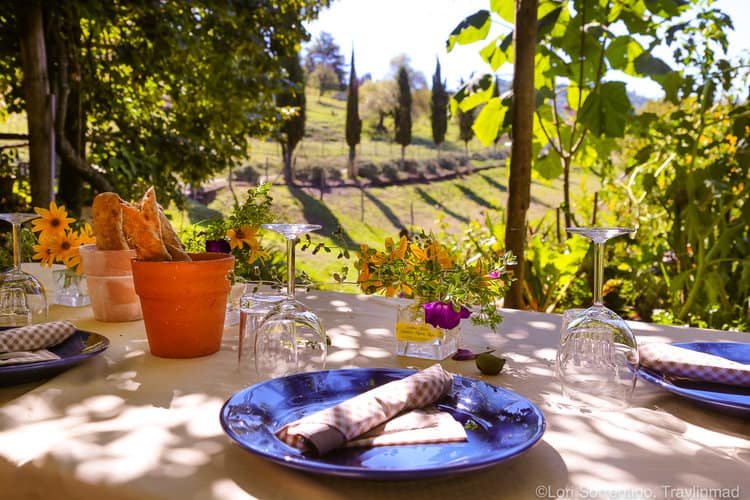Let’s face it — when it comes to traveling, we have a thing for authenticity. Established avid travelers don’t want manufactured tourism – the kind that doesn’t relate to an area’s culture or feels out of context for a place – it can even make you uncomfortable. And, it’s far from authentic.
Travelers today are looking for a deeper, more meaningful connection to the places they visit when they travel. They want to experience a place from a locals point of view, eating what they eat where they eat it, trying on for size the things a local might do every day — boring and routine to locals perhaps, but it’s the most gratifying experience for a traveler. This is how you ‘slow travel’. Let’s start with Tuscany in this comprehensive Tuscany Travel Guide, but the SLOW way!
Ultimate SLOW Tuscany Travel Guide
Slow Travel Tuscany
Through the wonders of social media, I “met” Arianna of Km Zero Tours last year and immediately felt a kindred spirit in her and her philosophy of authentic, slow travel – the very mission behind the tour company she runs with her partner Alessio. So I was beyond excited when they invited us to visit them in Chianti to learn more of what slow travel is all about.

Chianti Cashmere Goats in Tuscany
Slow travel is all about taking time to learn a culture, eat the food, and meet the people who create it.
We had been reading and dreaming about Italy for months and even watched movies to get inspired, but we had already been in Italy for a few weeks eating our way through Bologna and strolling and shopping the streets of Florence when we first met Arianna. We were excited to slow our pace for the next few days.

She met us with a big smile at our Florence Airbnb and we walked a few blocks to where Alessio waited with their van. By the time we cleared Florence traffic and were driving through Tuscany, we knew this was going to be fun! Arianna laid out the itinerary for our time together wanting us to experience all they’d planned and she gave us some initial insight into Km Zero Tours.
They’ve been organizing slow travel tours in Tuscany for the past 5 years sharing their home region with travelers searching for a more authentic experience. Here are some of the ways you can experience the authentic Tuscany.
Chianti Cashmere Goats

Chianti Cashmere is a cashmere goat farm and the largest producer of cashmere wool in Europe. Nora greeted us on our first visit there and we liked her immediately when we caught the remnants of her New York accent. She’s the owner and had been a veterinarian in Chianti for 25 years.
A short walk past a small yard with some fruit trees we found 30 or so beautiful goats in the pasture wrapped up in cashmere. All of them looked up momentarily to stare at us, but never once stopped chewing. We learned of Nora’s early beginnings in Chianti, her start as the first female veterinarian in the region, and how her passion for goats grew from owning a few to her current Chianti Cashmere operation that reaches around the world.
Lunch Under the Tuscan Sun

Spend the afternoon playing with the cashmere goats in the pasture then walk down to the lovely renovated barn and current owner’s residence overlooking the countryside for an amazing Tuscan lunch of local cheeses, rustic artisan bread, and other regional Italian foods of Tuscany.
Stay in a Tuscan agriturismo

A typical way to experience Tuscany is to stay in a local agriturismo, or farmstay. Il Macinello was our farmstay during our first week in Tuscany. What a lovely place! Surrounded by olive trees and vineyards, this beautifully restored villa is a picture perfect postcard of Tuscany that now welcomes travelers as an agriturismo, or farm stay.
We love staying in agriturismos when we’re in Tuscany and especially loved the farmhouse kitchen with a large gathering table that we never actually got to use. But next time, we’d love to spend time here with family and friends. And the view from our room over the vineyards and olive groves was to die for.
A Sunset Vineyard Hike

Tuscany is famous for its vineyards – miles and miles of them as you explore the countryside. But did you know you could get out into the vineyards for a closer look? We met Beppe, our guide for an afternoon picnic and hike through the vineyards, a perfect way to spend the afternoon.
We hiked along the Tignanello vineyards of the famous Antinori estate and Beppe talked about the soil and the vines. The sun was setting by the time we reached our destination on the far side of the hill, and he brought out a perfect little picnic from his backpack complete with wine that took the edge off our growing appetites. Dinner was waiting for us at Macinello so we headed back, where Massimo was preparing to grill his famous Bistecca Fiorentina!
Organic, Sustainable Farming in Maremma

Maremma is a lesser-visited and more rustic part of Tuscany where we visited Tenuta di Paganico, an agricultural and livestock breeding estate. Originally purchased in the 1920’s by a Tuscan family, the farm is now owned by, oddly enough, a vegetarian who believes in a productive, sustainable, organically influenced livestock farm.

The farm raises three breeds of cattle – Maremmana, Chianina, believed to be one of the oldest breeds in existence, and Limousin, a huge heavily muscled French breed.
They also raise Cinta Senese, the black and white belted Tuscan pigs. Although each has its own unique characteristics, they’re known for high quality meat, especially here where they are raised organically. Throughout our travels in this part of Italy the all-pervasive philosophy “You are what you eat” was never more apparent than here.
Organic Chianti Colli Senesi Wine

Located just outside the geographical area designated as Chianti is Pacina, a small organic winery estate. Because it’s outside of this arbitrary boundary the wine they produce is known as Chianti Colli Senesi. Their home here was first built as a convent around 900AD, and today Giovanna and her husband own the property that’s been in her family for six generations.
This area of Chianti is known for its wine and olive oil making, but they do things a little differently at Pacina. The wine they produce is entirely organic to ensure the highest quality possible. And most impressive to me was how connected they are with the land they farm and love. We were truly moved by such a beautiful place and people.
Tuscan Woodworking

Our visit to Giorgio’s woodworking shop was intriguing from the start. A happy guy with a big smile, he greeted us at his studio in the Tuscan hills, and we watched him as he worked with his lathe.
Giorgio uses many different woods – olive, ash, maple, oak, walnut and cherry from local wood farms to make his amazing creations. From utilitarian wood bowls, platters, and cutting boards, to large scale commissioned pieces for local churches and companies, his creations are works of art and crafted straight from the heart. Amazing!
Biodynamic Tuscan Wine

With Arianna and Alessio we visited Podere Erica, a beautifully restored farmhouse and organic winery located halfway between Florence and Siena. The scenery here is classic Tuscany, meticulously groomed vineyards and groves of olive trees.
This estate grows Muscat, Canaiolo, and Sangiovese grapes for their exquisite wines using biodynamic methods. Biodynamic farming goes beyond organic to actually revitalize and replenish the soil keeping the growing process more in concert with nature. After seeing their production process, we sat down with the owner, Jan and Marco, their winemaker, for a delicious lunch in their tasting room.
Authentic Florentine Leather Craft

In the creative heart of Florence you will find the bottega of Dimitri Villoresi, a passionate and skilled leather craftsman. Stepping into Dimitri’s workshop was like stepping back in time. The open front door invited friends to say hello as they passed by, while inside he quietly worked with customers to choose the right color leather for their bags. We watched as he worked on several pieces, chatting with him about the handcrafted Florentine traditions to which he clings so tightly.
Cheesemaking in Tuscany

A visit to Podere Il Casale is a perfect glimpse into the sustainable, organic slow food movement started in Italy and nurtured by owners and local cheese producers Sandra and Ulisse. Along with organic honey, wine, extra virgin olive oil, and saffron, they produce the delectable pecorino cheese that Pienza is known for.
A visit here is a glimpse into the unique specialties that define Italy’s regional food. The farm offers cooking classes, cheesemaking classes, and other culinary events. But taking a tour of the farm and then sitting down for an in-depth cheese tasting introduces you to the real subtleties of the farm-to-table concept: tasting what the animals grazed on, at that particular time of year, and the time it took to create and develop the flavors of the cheese. That’s slow food!
Silver Artisan in San Gimignano
To watch an artisan so skilled that they can can turn a strip of silver into a work of art in less than an hour is a special experience. And when that work of art adorns your finger and reminds you of the experience again and again, that’s the essence of slow travel. The small workshop of Matteo Macallè and his artisans in San Gimignano is the place to stop and make a small souvenir purchase to remember the time you slow-traveled Tuscany.
Organic Vernaccia di San Gimignano Wine
Tuscany is world-renowned for their bold red wines – Chianti, Brunello di Montalcino, Vino Nobile di Montepulciano – and their white wines often take a back seat. But not for long. Wineries like Cappella Sant’Andrea are changing that, and a visit to San Gimignano is a must on the most popular Tuscany wine tours. Their wine is produced naturally and organically in soil that was once the Ligurian Sea, giving a superb mineral essence to the wine.

Handcrafted, At The Source (Zero Kilometers)
From visit to visit, with each new producer we’ve met and experiences we’ve had, the same theme keeps recurring, one which has resonated with me my entire life. Each of these producers embodies the spirit of handcrafted. Whether they produce wine, leather goods, meat, cashmere wool, or handcrafted wood, all are deeply rooted in their belief of producing authentic high quality goods from sustainable sources.
It made our hearts happy to see food and winemakers letting nature determine the course of production, protecting and sustaining the ecosystem by being good stewards of the land. And craftsmen and artisans who hold tightly to old tools and traditions for producing works of art.
The times we have spent with Arianna and Alessio have reinforced the part of me that values authenticity. That local flavor you can’t get anywhere else but at the source. And the more local it is, the better the experience will be. That’s the meaning behind Km Zero Tours. The name Km Zero refers to zero kilometers between the producer and you.
They’re redefining what it means to see Italy by introducing visitors to the local community and the producers who make it all come alive. And when you buy local and experience local, the reward is a more enriching kind of travel that benefits everyone.
For the visitor who wants to ‘slow travel’ Italy and experience Tuscany in a real and authentic way, at a pace that’s relaxed, we can’t recommend them enough. We could not have seen it the way we have without them. Their introduction is everything, and their philosophy of “slow travel” makes every place you visit a place you want to stay longer and truly get to know.
Grazie mille Arianna e Alessio. Bravissimo!!
__________
Note: We were guests of KmZeroTours during our stays in Tuscany, and we appreciate their introduction to these producers. As always, opinions are ours alone based on our firsthand experience.
“Lori Sorrentino is the Editor and Photographer for Travlinmad, a food and travel blog specializing in slow travel and local food experiences. She caught the photography bug as a kid, and started traveling soon thereafter, a combination that eventually led to a career in tourism and destination marketing. She hails from New Jersey but now calls Florida home, and she travels full-time making local connections, discovering new food experiences, and photographing the colors, details and textures wherever she goes.”












